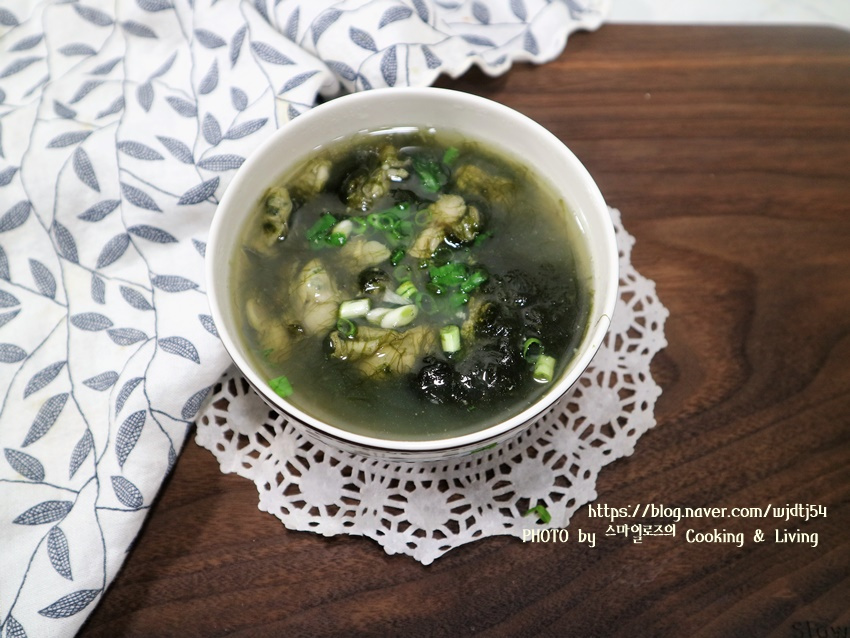Seaweed and Oyster Soup: A Taste of Winter’s Ocean
How to Make Seaweed and Oyster Soup: A Seasonal Delicacy

As the weather turns cold, my absolute favorite ingredients are seaweed (maesaengi) and oysters! This recipe for Maesaengi Guk (Seaweed and Oyster Soup) uses these wonderful ingredients, brimming with the fresh scent of the sea. The vibrant green of the maesaengi, gently swirling in the broth like waves, creates a beautiful visual. This delicious oyster and seaweed soup is packed with oceanic flavor. You don’t need fancy seasonings; it’s incredibly refreshing and savory on its own, making it a perfect #DecemberSeasonalDish and #SeasonalSeafood dish. Legend has it that this soup was once given to an ‘unloved son-in-law’ because its steam doesn’t rise, making it deceptively hot and easy to burn your mouth! Maesaengi is in season now, and pairing it with oysters enhances its flavor even further. While the cooking method is simple, the taste is so memorable you’ll crave it again and again. Although the fine, hair-like strands of maesaengi might not look the most appealing, their taste is undeniably irresistible. Get ready to enjoy this delightful winter soup!
Main Ingredients- Maesaengi (seaweed) 200g
- Fresh Oysters 200g
Anchovy and Kelp Broth- Water 6 cups (approx. 1200ml)
- Dried Anchovies 15 fish
- Dried Radish (Mu) a small amount
- Kelp 1 sheet (10cm x 10cm)
Seasoning- Korean Soup Soy Sauce (Gukganjang) 2 Tbsp
- Fish Sauce (or alternative like Jin Ganjang) 1 Tbsp
- Minced Garlic 0.7 Tbsp (approx. 10g)
- Water 6 cups (approx. 1200ml)
- Dried Anchovies 15 fish
- Dried Radish (Mu) a small amount
- Kelp 1 sheet (10cm x 10cm)
Seasoning- Korean Soup Soy Sauce (Gukganjang) 2 Tbsp
- Fish Sauce (or alternative like Jin Ganjang) 1 Tbsp
- Minced Garlic 0.7 Tbsp (approx. 10g)
Cooking Instructions
Step 1
Gently rinse the prepared maesaengi by placing it in a sieve under cool running water 2-3 times. Maesaengi is very delicate and slippery, so avoid washing it vigorously, as it can disintegrate. Gently swirl it in the water to clean, then drain thoroughly.

Step 2
Wash the fresh oysters in cold water with a pinch of salt. Use chopsticks or a spoon to gently stir and loosen any dirt or shell fragments. Rinse 2-3 times until clean, then drain them well in a sieve. (While some methods use radish juice, salt is usually sufficient for cleaning.)

Step 3
In a deep pot, combine 6 cups of water. In a dry pan, lightly toast the dried anchovies for 1-2 minutes over medium heat to remove any fishy odor. Add the toasted anchovies, kelp, and dried radish to the pot. Bring to a boil over high heat, then reduce to medium-low and simmer for 10 minutes to create a rich and savory broth. (Using dried radish in the broth adds a deeper umami flavor.) Once the broth is ready, strain out all the solids.

Step 4
To maintain the soup’s clean and refreshing taste, we’ll add the maesaengi directly to the broth without sautéing. Once the anchovy-kelp broth comes to a boil, add the prepared maesaengi, cutting it into 2-3 manageable pieces. This helps the maesaengi disperse evenly without making the broth cloudy.

Step 5
As the maesaengi begins to soften and integrate into the broth, add 2 Tbsp of Gukganjang (Korean soup soy sauce), 1 Tbsp of fish sauce (or substitute with Gukganjang if unavailable, using a total of 3 Tbsp), and 0.7 Tbsp of minced garlic. Let it simmer gently to allow the flavors to meld together.

Step 6
Once the soup returns to a gentle boil, add the fresh oysters. Oysters can become tough and shrunken if overcooked, so it’s crucial to cook them just until they are plump and cooked through, about 2-3 minutes. Turn off the heat immediately after they are cooked.

Step 7
With the addition of minced garlic, this Maesaengi Guk beautifully balances the fresh oceanic aroma of the seaweed and oysters while eliminating any potential fishiness. This vibrant, flavorful, and seasonal dish is now ready. It’s a visually appealing and delicious dish that’s perfect for whetting your appetite.

Step 8
For an extra touch of freshness, you can garnish with finely chopped green onions or scallions at the end. While a drizzle of sesame oil is optional, it might slightly diminish the soup’s clean and refreshing character. If you choose to add it, use only a very small amount.

Step 9
This Maesaengi Guk, with its lush green seaweed and plump oysters floating within, evokes the feeling of the winter sea. It’s a nutritious and incredibly delicious winter delicacy that I highly recommend you try!



